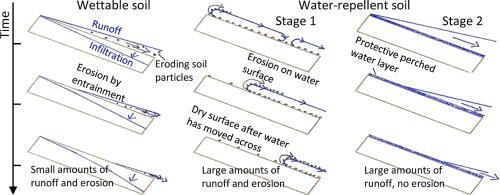Soil and Tillage Research ( IF 6.1 ) Pub Date : 2020-09-08 , DOI: 10.1016/j.still.2020.104756 Mary-Anne Lowe , Gavan McGrath , Matthias Leopold

|
Soil water repellency (SWR) increases the amount of runoff and erosion from soils. Previous experiments on water-repellent soils had shown intricate runoff movement and high rates of water and soil losses; our aim was to observe these processes, noting their influences and quantifying impacts. The experiment used a 60 × 60 cm rainfall simulation plot setup to represent an agricultural plot with packed water repellent soil and no interference of plants. We measured inputs, and monitored surface flows and erosion on 3°, 6° and 9° slopes. A surfactant treated plot was used as a control. Eroded sediment samples were collected and measured for particle size, and together with runoff analysed for organic carbon, nitrogen and macronutrients. Runoff coefficients were high (0.53 to 0.78) for untreated soil with erosion decreasing over the course of the experiment (1.41 t ha-1 to 0.74 t ha-1 over five 2 mm rainfall events, of 2 min duration, on the 9° slope). This resulted in cumulative erosion of up to 5.35 t ha-1 after a total of 10 mm of rainfall (5 × 2 mm). Importantly, silt and clay were preferentially eroded (up to 12 × higher in eroded soil than the baseline composition) and this correlated with the loss of organic carbon, nitrogen, and macronutrients. As expected, the steepest slope (9°) caused greater runoff and erosion than the lowest (3°), however, there was no significant difference in runoff and erosion between the 6° and 9° slope. Surfactant significantly decreased runoff coefficients by two orders of magnitude compared to the untreated soil. Surface flow was initially characterised by beading and rivulet formation, minimising soil contact. Over time, however, a perched, protective water layer formed over the surface, allowing subsequent water flow with reduced soil interaction. The runoff mechanisms for these small rain events were only observed on the water-repellent soils and likely reduced the degree of erosion given the high runoff coefficients. Initial water flow also promoted armouring of the soil by the attraction of smaller particles, leading to increased loss of organic carbon and nitrogen as well as macronutrients.
中文翻译:

土壤防水性和坡度对径流和侵蚀的影响
土壤防水性(SWR)增加了径流和土壤侵蚀。先前在憎水土壤上进行的实验表明,径流运动错综复杂,水土流失率很高。我们的目的是观察这些过程,注意它们的影响并量化影响。该实验使用60×60厘米的降雨模拟样地设置来代表一个农业地区,该地区种植了憎水土壤,没有植物的干扰。我们测量了输入量,并监测了3°,6°和9°斜面上的地表流动和侵蚀。使用表面活性剂处理的样区作为对照。收集侵蚀的沉积物样品并测量粒径,并与径流一起分析有机碳,氮和大量营养素。径流系数很高(0.53至0。在9°坡度上持续2分钟的5次2 mm降雨事件中-1至0.74 t ha -1)。这导致累积侵蚀高达5.35 t ha -1总共10毫米的降雨(5×2毫米)之后。重要的是,淤泥和粘土被优先侵蚀(在侵蚀的土壤中比基线组成高12倍),这与有机碳,氮和大量营养素的流失有关。正如预期的那样,最陡的坡度(9°)比最小的坡度(3°)引起更大的径流和侵蚀,但是,在6°和9°坡度之间,径流和侵蚀没有显着差异。与未处理的土壤相比,表面活性剂使径流系数显着降低了两个数量级。地表流最初的特征是成珠和形成小溪,使土壤接触最小化。但是,随着时间的流逝,在表面上会形成一个栖息的保护性水层,从而使后续的水流减少了土壤的相互作用。这些小雨事件的径流机制仅在憎水的土壤上观察到,考虑到较高的径流系数,可能会减少侵蚀程度。最初的水流还通过吸引较小的颗粒而促进了土壤的铠装,导致有机碳和氮以及大量养分的损失增加。











































 京公网安备 11010802027423号
京公网安备 11010802027423号